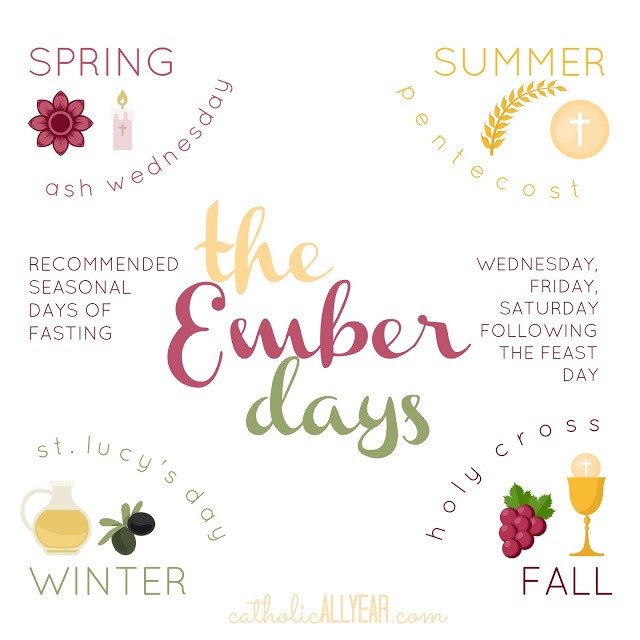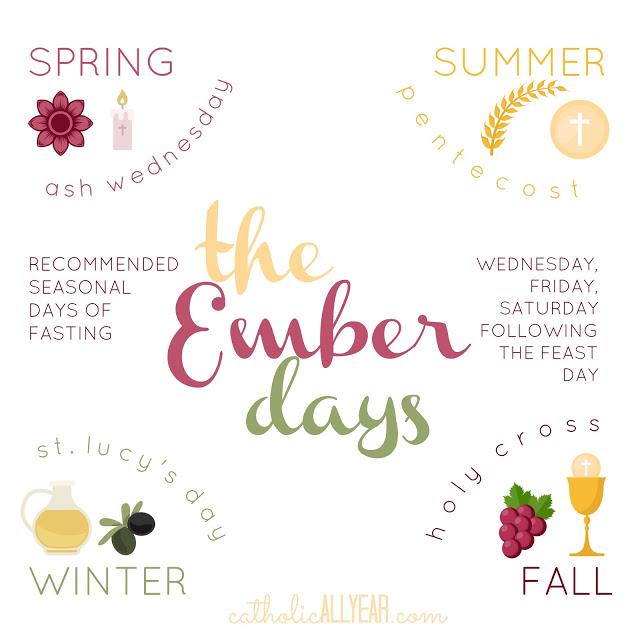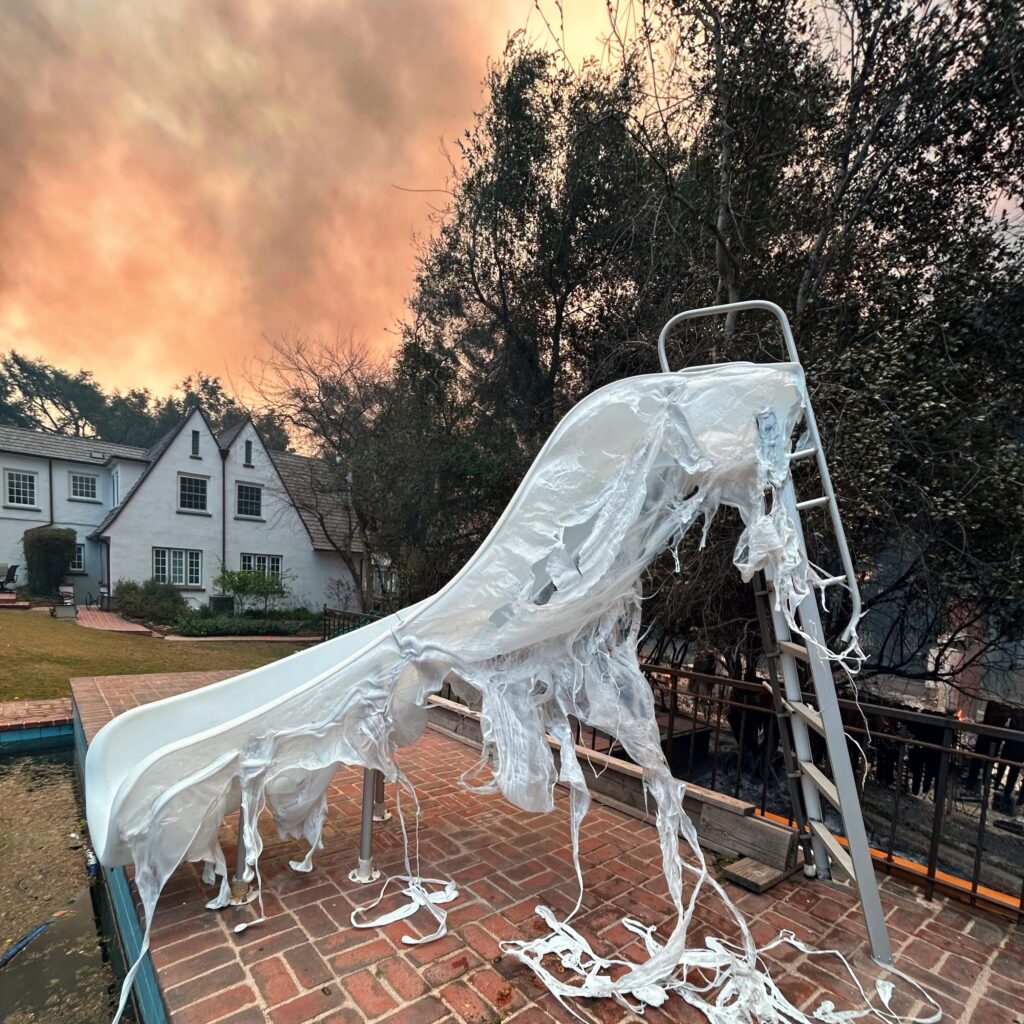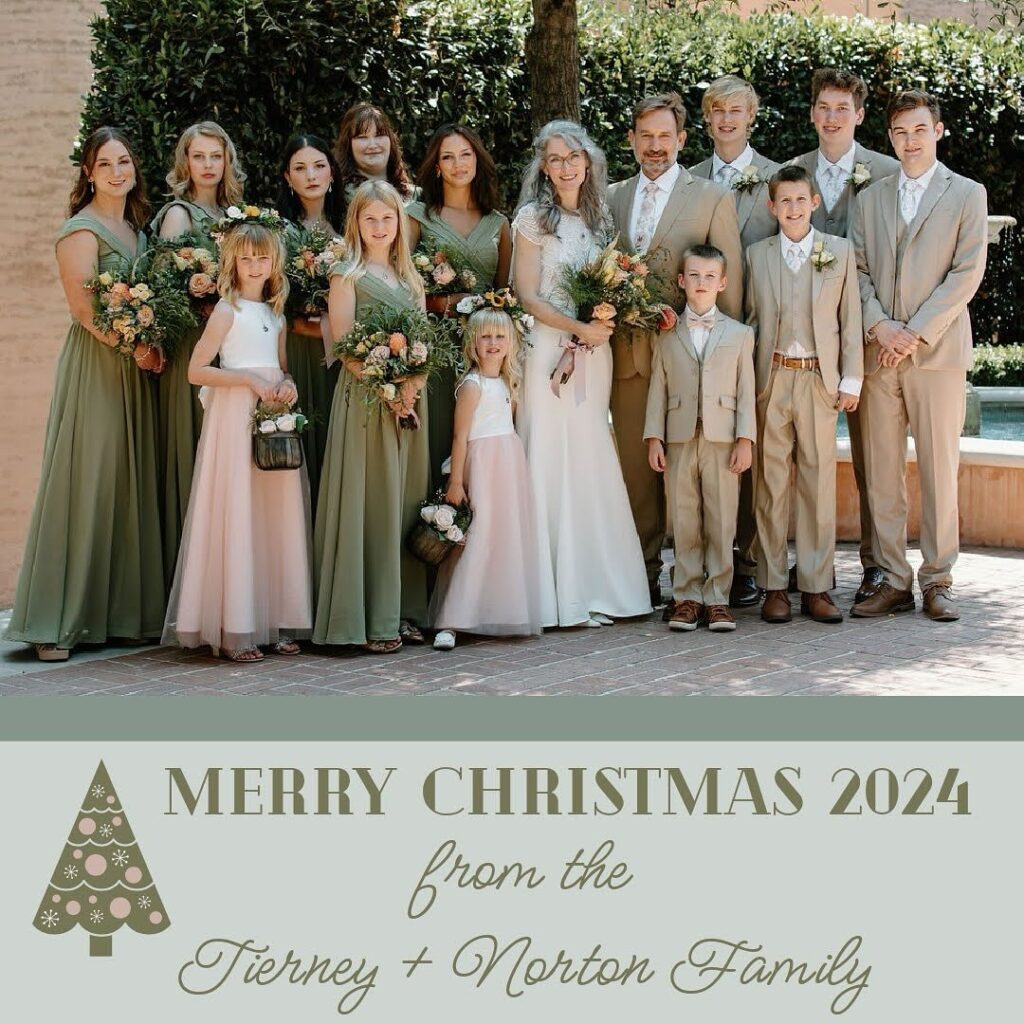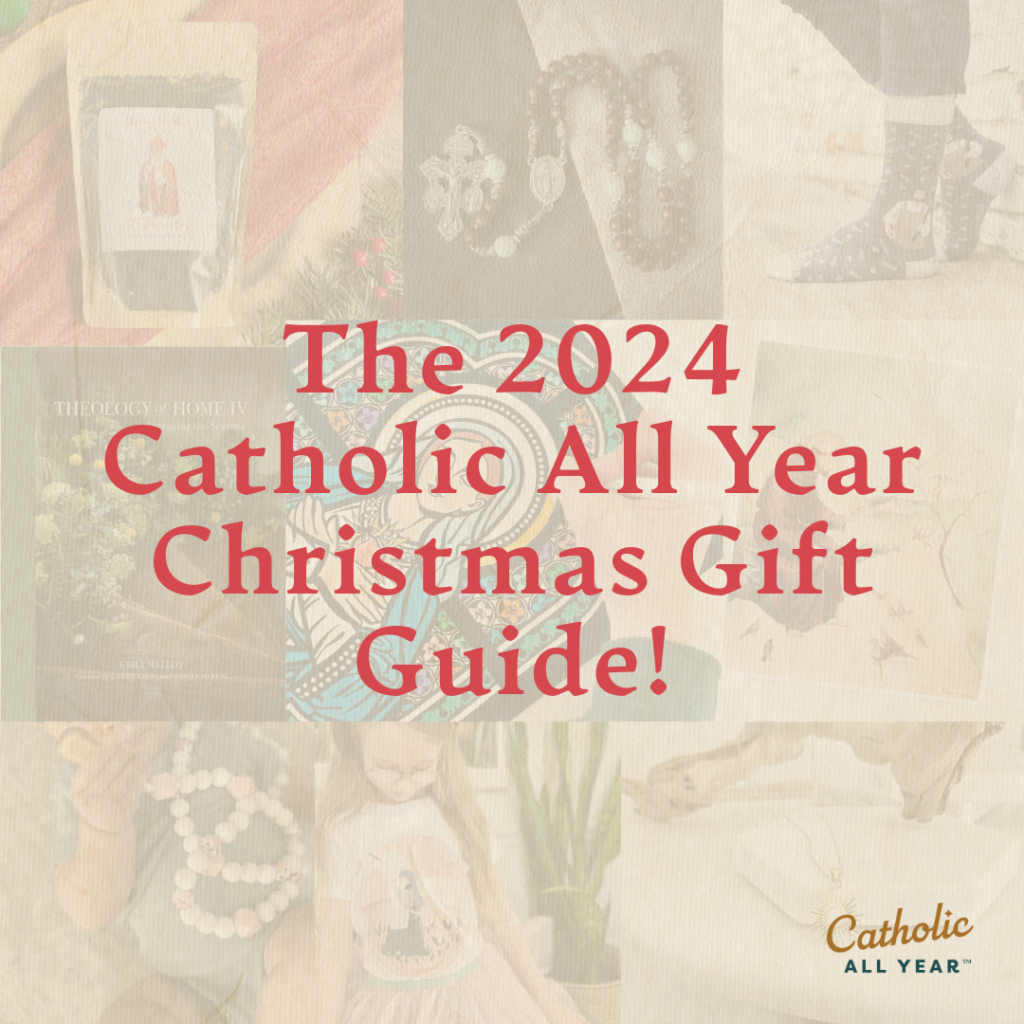I’ve been Catholic for forty-one years, actually making an effort for seventeen, a liturgical living devotee for eleven, and blogging about it for five.
And . . . I just found out about Ember Days.
As I was researching feast days for the Catholic All Year Compendium (my upcoming book, not sure yet of the release date, it’s still in the editing process) and the CAY wall calendar, I stumbled across a couple references to Ember Days and finally decided to look into them. I marked them on the calendar, and a few folks have asked me about them already, so I figured I’d give you a quick rundown of what I learned, and how I hope to incorporate them into our family life in the coming year.
- The Ember Days are four sets of three days of penance, one set at the beginning of each season.
- They occur on the Wednesday, Friday, and Saturday of the same week.
- Wednesday is memory of Judas’ betrayal.
- Friday is in memory of the crucifixion.
- Saturday is in memory of the tomb.
- The individual feast days aren’t involved with the penance, they’re just reminders of when the Ember Days fall (although two of the feast days are penitential in themselves).
- The winter Ember Days follow St. Lucy’s Day (December 13th) and are offered in thanksgiving for the olive harvest, which gives us holy oils.
- The spring Ember Days follow Ash Wednesday (movable, forty-six days before Easter) and are offered in thanksgiving for the flowers, which feed the bees, who make the wax, that gives us the altar candles.
- The summer Ember Days follow Pentecost (movable, the eighth Sunday after Easter) and are offered in thanksgiving for the wheat harvest, which gives us the Eucharist.
- The fall Ember Days follow the Exaltation of the Holy Cross (September 14th) and are offered in thanksgiving for the grape harvest, which gives us the Precious Blood.
- If the feast day falls on a Wednesday, the Ember Days begin on the following Wednesday.
- The penance is traditionally fasting on Wednesday and Saturday, and fasting and abstinence from meat on Friday.
- Current fasting norms in the U.S. permit one full meal, as well as two smaller meals that together are not equal to a full meal.
- Abstinence is binding from age fourteen. Fasting is binding from age eighteen to fifty-nine (except for those exempt for reasons of age or health).*
- Until 1966, the Ember Days were a required observation for all Catholics (except for those exempt for reasons of age or health).
- Since 1966, observation is left up to the discretion of the local bishops.**
- In the U.S., observation of the Ember Days is recommended, but not mandatory.***
There are often thirteen people living in our home, and only one is bound by the fast. The rest of us are too old, too young, or too pregnant and/or nursing (currently just the second part) to be required to fast. We already observe regular Friday abstinence from meat. But I feel like, with as much feasting as we do, I’d like to incorporate these voluntary days of penance into our family routine as well. So, my plan is to treat them like days of Lent, and recall the voluntary Lenten disciplines that we usually observe as a family for those three days of each season. For us, that’s no treats, no snacks, no TV. Since the spring days follow Ash Wednesday, we’ll already be doing them then. But I think the other three weeks will be a good reminder of the penitential spirit and detachment we work to cultivate during Lent, but shake off pretty easily come Easter.
It’s a bit tricky to remember when the Ember Days will occur in a given year, since the Wednesday after a particular date is going to be different each year, and especially since two of the reminder feast days are movable in themselves.
But . . . I put them on the calendar, so I’m hopeful that this is the year Ember Days happen for us!If you have experience observing Ember Days in your home, especially with a family, I’d love to hear about what you do.Updated to add . . .
Rogation Days!
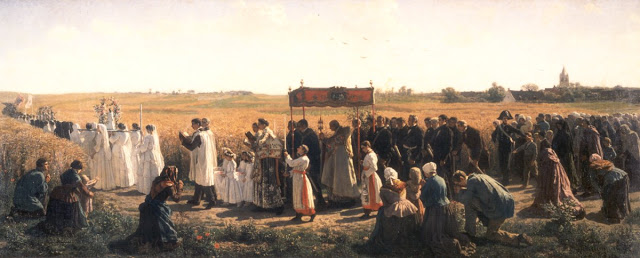 |
| The Blessing of the Wheat in Artois, 1857 – Jules Breton |
Another category of now-little known days of penance are the rogation days. The major rogation falls on the feast of St. Mark, April 25th (but is unrelated to the Evangelist), and the minor rogation days fall on the Monday, Tuesday, and Wednesday before the Ascension. It’s an unlikely time for extra days of penance, as it’s during Eastertide, but they were offered to God during the spring planting season in the hopes that the wheat crop would be protected from natural disasters. Though often referred to as fasting days, during the Easter season, they would have been observed as days of abstinence from meat, but not days of fasting. It is traditional, on the major rogation day to recite the Litany of All Saints, and to walk in procession around the boundaries of the parish, blessing the crops.
For those of us who live where parishes are big and crops are few, we could offer our prayers and abstinence from meat for farmers and for the victims of natural disasters.
Finally, there are the Vigils.
There are historical fasts associated with the vigils of a few important feast days. In the U.S. they are the vigils of Christmas, Pentecost, the Immaculate Conception (8 December), and All Saints (31 October). Fasting and abstinence are officially recommended on these days, as well as on Holy Saturday.
It can seem, well, crazy for those of us who grew up without any tradition of observing the vigils of these feast days. Especially for those of us in America who grew up celebrating Halloween and Christmas Eve as basically feast days unto themselves. But we have begun observing abstinence in our house on these vigil days, and it really has brought a sense of mindful preparation to those days. Fortunately Halloween candy is meat-free!
If you’d like to keep track of ALL the feasts of the Catholic liturgical year, I’ve created a wall calendar to help you do it!
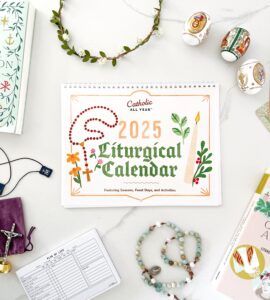
Get a physical copy here and the PDF version here!
It features the all the feasts and fasts of the Universal Calendar and then some, illustrated with images featuring the traditional Catholic monthly devotions. It’s an easy visual way to bring liturgical living into your home. You can keep track of the feasts and fasts and seasons of the Catholic year, and be reminded to focus your prayer on a different aspect of our faith each month.
As the Church year begins with December, so does this calendar. You get December 2024 through December 2025, thirteen months. Available for purchase here. Thanks!
* Can. 1252 The law of abstinence binds those who have completed their fourteenth year. The law of fasting binds those who have attained their majority, until the beginning of their sixtieth year. Pastors of souls and parents are to ensure that even those who by reason of their age are not bound by the law of fasting and abstinence, are taught the true meaning of penance.
** On rogation and ember days the practice of the Church is to offer prayers to the Lord for the needs of all people, especially for the productivity of the earth and for human labour, and to make public thanksgiving. In order to adapt the rogation and ember days to various regions and the different needs of the faithful, the conferences of bishops should arrange the time and plan of their celebration. Consequently, the competent authority should lay down norms, in view of local conditions, on extending such celebrations over one or several days and on repeating them during the year. On each day of these celebrations the Mass should be one of the votive Masses for various needs and occasions that is best suited to the intentions of the petitioners.
–General Norms for the Liturgical Year Calendar, Apostolic Letter of Pope Paul VI, Paenitemini, 1966
*** Vigils and Ember Days, as most now know, no longer oblige to fast and abstinence. However, the liturgical renewal and the deeper appreciation of the joy of the holy days of the Christian year will, we hope, result in a renewed appreciation as to why our forefathers spoke of “a fast before a feast.” We impose no fast before any feast-day, but we suggest that the devout will find greater Christian joy in the feasts of the liturgical calendar if they freely bind themselves, for their own motives and in their own spirit of piety, to prepare for each Church festival by a day of particular self-denial, penitential prayer and fasting.
–Pastoral Statement On Penance And Abstinence: A Statement Issued by the National Conference of Catholic Bishops November 18, 1966

